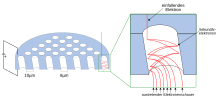User:Adrian-xuv/sandbox
 Schematic diagram of the operation of a microchannel plate | |
| Related items | Daly detector Electron multiplier |
|---|---|
Microchannel Plate[edit]
A microchannel plate (MCP) is a thin disk with many tiny holes in it used for the detection of light (particularly ultraviolet and X-rays) and of single particles such as electrons, ions or neutrons. A single hole, or microchannel of an MCP, behaves like an electron multiplier, converting incoming particles or radiation to electrons and then multiplying them by secondary emission while the array of many microchannels in an MCP provides spatial resolution and 2D imaging. Their main use is for image intensification, especially in night vision equipment.
Design and Manufacture[edit]
A microchannel plate is a slab made from resistive material (most often glass) 0.5 to 2mm thick with a regular array of tiny tubes (microchannels) leading from one face to the other. The microchannels are typically 5-20 micrometers in diameter, parallel to each other and enter the plate at a small angle to the surface (8-13° from normal). Plates are often round disks, but can be cut to any shape from sizes 10mm up to 200mm. They may also be curved.
MCPs are made by repeated drawing and stacking of hollow glass tubes.
Operation[edit]
A particle or photon that enters one of the channels is guaranteed to hit the wall of the channel, due to the channel being at an angle to the plate normal. The impact starts a cascade of electrons that propagates through the channel, amplifying the original signal by several orders of magnitude, depending on the electric field strength and the geometry of the microchannel plate. After the cascade, the microchannel takes time to recover (or recharge) before it can detect another signal.
The electrons exit the channels on the opposite side of the plate, where they are collected on an anode. Some anodes are designed to allow spatially resolved ion collection, producing an image of the particles or photons incident on the plate. Although, in many cases, the collecting anode functions as the detecting element, the MCP itself can also be used as a detector. The discharging and recharging of the plate produced by the electron cascade, can be decoupled from the high voltage applied to the plate and measured, to directly produce a signal corresponding to a single particle or photon.
The gain of an MCP is very noisy, meaning that two identical particles detected in succession will often produce very different signal magnitudes. Employed in this way, MCPs are capable of measuring particle arrival times with very high resolution, making them ideal detectors for mass spectrometers.
ion feedback
Photocathode[edit]
The material on the input side (the most negative, or cathode side) of the MCP does the photon (or particle) to electron conversion and is called a photocathode. As bare MCPs are coated with a thin layer of metal that is not efficient at converting photons to electrons, it is common to coat the input side of the MCP with a material that readily emits electrons. Materials used for photocathodes have low work functions such as mixtures of alkali metals, or alkali metal halides.
It is possible to put the photocathode layer on a window just above the MCP and have the electrons travel across the gap to the MCP's front surface, guided by an electric field.
MCP Detector[edit]
To make a
anode readout types: single pixel, phosphor, resistive, XDL, DDL, XS
photos: some anodes (phosphor, XDL, DDL, XS, resistive)
photos: detectors; large, small, curved, QE grid, photocathode, tube, with door
Advantages and Disadvantages of MCP detectors[edit]
+ detector noise is low, limited by local radioactivity
+ temporal resolution <50ps
+ can survive (non-operationally) UHV bakeout temperatures (350C)
+ not susceptible to radiation damage to ...
- require high voltages (to 5kV) and HV engineering for operation
- require vacuum for operation (<1e-5mbar)
- can suffer permanent gain loss after long exposure
- it can be difficult for those not familar with MCPs. many of the parameters by which other imaging technologies are compared, such as pixel size, dark noise and readout noise have no relevance to MCPs (that don't have physical pixels and inherently have no readout noise)
Other type of MCPs[edit]
Square pore MCPs for imaging

